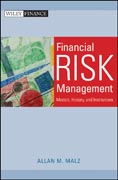
An in-depth look at the tools and techniques professionals use to address financial risks Risk and uncertainty, as Allan Malz explains in his ground-breaking new book, are two completely different concepts. Risk is a quantifiable uncertainty that can be modeled, while uncertainty defines non-quantifiable outcomes that are not always known. Part art and part science, the study of risk remains a relatively new discipline in finance and economics that continues to be refined. Financial crisis, rather than destroying the need for risk management, has given even great nuance and meaning to what risks exist and can be managed and controlled, and a taxonomy of new risks that need to be explored in ever more meaningful ways. This definitive guide on financial risk Explores allthe tools and techniques needed to cope with risk Addresses state of the art approaches to modeling and managing risks Investigates stress tests in periodsof heightened uncertainty, and the impact that variables such as liquidity and correlations can have on risk mitigation Provides practicing risk professionals with useful rules of thumb, intuitions, and insights gleaned from Malz's entire career as risk researcher, chief risk officer, and financial market regulator outside his classroom at Columbia University Informative and engaging, this book will help you understand why risk has become its own essential discipline on Wall Street and beyond. INDICE: Preface. 1 Financial risk in a crisis-prone world. 1.1 Some history: why is risk a separate discipline today? 1.2 The scope of financial risk. 2Market risk basics. 2.1 Arithmetic, geometric, and logarithmic security returns. 2.2 Risk and securities prices: the standard asset pricing model. 2.3 The standard asset distribution model. 2.4 Portfolio risk in the standard model. 2.5 Benchmark interest rates. 3 Value-at-Risk. 3.1 Definition of value-at-risk.3.2 Volatility estimation. 3.3 Modes of computation. 3.4 Short positions. 3.5Expected shortfall. 4 Nonlinear risks and the treatment of bonds and options.4.1 Nonlinear risk measurement and options. 4.2 Yield curve risk. 4.3 Fixed-income VaR using duration and convexity. 5 Portfolio VaR for market risk. 5.1 The covariance and correlation matrices. 5.2 Mapping and treatment of bonds andoptions. 5.3 Delta-normal VaR. 5.4 Portfolio VaR viaMonte Carlo simulation. 5.5 Option vega risk. 6 Credit and counterparty risk. 6.1 Defining credit risk.6.2 Credit risky securities. 6.3 Transaction cost problems in credit contracts. 6.4 Default and recovery: analytic concepts. 6.5 Assessing creditworthiness. 6.6 Counterparty risk. 6.7 TheMerton model. 6.8 Credit factor models. 6.9 Credit risk measures. 7 Spread risk and default intensity models. 7.1 Credit spreads. 7.2 Default curve analytics. 7.3 Risk-neutral estimates of default probabilities. 7.4 Spread risk. 8 Portfolio credit risk. 8.1 Default correlation. 8.2 Credit portfolio risk measurement. 8.3 Credit VaR with the single-factor model. 8.4 Using simulation and copulas to estimate portfolio credit risk. 9 Structured credit risk. 9.1 Structured credit basics. 9.2 Credit scenario analysis of a securitization. 9.3 Measuring structured credit risk via simulation. 9.4 Standard tranches and implied correlation. 9.5 Issuer and investor motivations for structured credit. 10 Alternatives to the standard market risk model. 10.1 Real-world asset price behavior. 10.2 Alternative modeling approaches. 10.3 The evidence on non-normality in derivatives prices. 11 Assessing the quality of risk measures. 11.1 Model risk. 11.2 Backtesting of VaR. 11.3 Coherence of VaR estimates. 12 Liquidity and leverage. 12.1 Funding liquidity risk. 12.2 Markets for collateral. 12.3 Leverage and forms of credit in contemporary finance. 12.4 Transactions liquidity risk. 12.5 Liquidity risk measurement. 12.6 Liquidity and systemic risk. 13 Risk control and mitigation. 13.1 Defining riskcapital. 13.2 Risk contributions. 13.3 Stress testing. 13.4 Sizing positions.13.5 Risk reporting. 13.6 Hedging and basis risk. 14 Financial crises. 14.1 Panics, runs, and crashes. 14.2 Self-reinforcing mechanisms. 14.3 Behavior of asset prices during crises. 14.4 Causes of financial crises. 14.5 Anticipating financial crises. 15 Financial regulation.
- ISBN: 978-0-470-48180-6
- Editorial: John Wiley & Sons
- Encuadernacion: Cartoné
- Páginas: 864
- Fecha Publicación: 11/05/2011
- Nº Volúmenes: 1
- Idioma: Inglés
